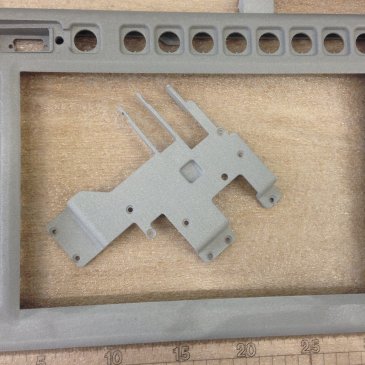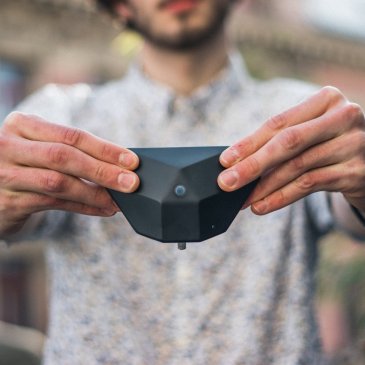If you need to produce a small series of electronic products, such as a card reader, it is not worth investing in the production of an injection mold. You can make the necessary covers or boxes most efficiently using a suitable 3D printing method.
If we are talking about the production of smaller components, where precision and surface quality are very important, 3D printers operating on the principle of liquid photopolymer curing are the best choice. We have a choice of SLA, LCD or DLP technologies, which differ in the light source used for photopolymerization. DLP technology, which uses high-performance digital projectors to create thin layers of polymer, enables fast and precise printing processes with high quality.
We initially decided on the Phrozen Transform printer with the hope of quality outputs, but quickly ran into a number of issues. Despite the heating, we encountered inaccuracies and lines on the products, which caused significant difficulties in their final completion. Printing took a long time, often up to ten hours, and the surface quality was not ideal. We had to spend a lot of time and resources on manual adjustments, including sanding and sealing, which increased the overall cost of production. After this frustrating experience, we decided to try printing on the Asiga PRO 4K XL printer. This pinter is equipped with a wide range of features, including layer height control sensors, to ensure precise and consistent output. Thanks to these improved features, we have not only achieved better print quality, but also saved time and reduced the cost of manual editing.
The Asiga PRO 4K XL is a leading 3D printer using DLP technology to produce large industrial parts and prototypes. With a print volume of 217 x 122 x 400mm, it allows working with large models and offers a high level of accuracy and print quality. It uses the latest LEDs and patented SPS™ technology for precise layering and fast print times. Thanks to the UV LED light source with a resolution of up to 4K mode 56 µm / native mode 80 µm in the X and Y axis with an extraordinary resolution in the Z axis, it allows you to create detailed parts. It is on the LCD 3D printer Asiga PRO 4K XL that we will describe a sample example of the production of a cover for electronics.
Preparing the model for printing
Before we proceed to the 3D printer itself, it is necessary to optimize the initial CAD model of the product. Applications such as Netfabb or Materialize Magics will help with geometry corrections as well as with the optimal design of the necessary print supports (taking into account the center of gravity of the product), which are also generated in such a way that they can be easily broken off, thus simplifying the necessary post-processing. In Materialise Magics, you can also have an analysis of the success of the print calculated and adjust the printing process if necessary according to its results. At this stage, it is possible to define the production series and its placement on the printing platform, and everything is completed by "slicing" (or "slicing") the model to the printing layers.
Preparation for 3D printing includes optimization of printed models, their appropriate orientation and placement on the printing surface. A series of 12 such boxes can be produced in about 5 hours.
Technological nuances of additive manufacturing
In the operating software for the 3D printer, which in this case is Asiga Composer, the definition of detailed printing parameters will take place, which are mainly based on the material used. The experience of the operator, gained mainly through practice, plays a big role here. When printing from photosensitive resins, the orientation of the created product during the printing process is very important. Appropriate rotation will contribute not only to the best possible processing of the viewing surfaces, but can be decisive for the success of 3D printing as such. Therefore, depending on the geometry of each product, it can be chosen differently - most often in the range of 30 to 45°. When choosing the orientation, it is also important to minimize the cross-sectional area (or in the printing layer) so that the product is subject to as little buoyancy as possible when the printing liquid is extruded. In small series production, you will appreciate the homogenous quality of the prints, when shape and dimensional accuracy are very important, especially for the individual components of later printed assemblies, so that everything fits together as it should during assembly.
In order to achieve constant conditions, the operator used the heating of the printing chamber, which contributes to reducing the viscosity of the printing material. In this way, especially with dense materials, you can achieve greater accuracy of layers, better quality surfaces and also reduce the risk of printing errors. In addition, heating allows working with very resistant materials that are in demand in industry and as such are used in more expensive industrial 3D printers.
Material corresponding to industrial requirements
The material Loctite 3D 3843 HDT60 was chosen for the production of boxes, which resembles ABS in its properties, which was modified by adding black pigment, which further improved its printability. It is mainly used in applications where surface details and strength are important. It is therefore directly intended for 3D printing of functional parts, such as this case. One of the advantages of the Loctite 3843 material is also its good machinability. Thanks to this, after printing, the surface treatments of the products were very quick and took a few minutes to complete. It was enough to simply separate the optimally generated supports from the model and sand the remaining small irregularities located only on one edge of the printed product with 400 grit sandpaper. In the finale, the surface was unified by a spray of black matte paint, after which the produced parts give the impression that they were not created in a 3D printer, but in an injection mold.
Small series production by 3D printing
At Cotu, they produce batches of components in this way for clients in various fields. Thanks to their extensive experience not only with 3D printing but also in the field of vacuum casting and surface treatment, Cotu specialists can choose the most suitable method for the given purpose of product use case. If you are looking for similar manufacturing services or want your own 3D printer suitable for making precision covers for electronics, at Cotu you will find all the answers and products to fully meet your needs.
Do you want to bring your idea to life? Contact us for professional advice in SLA 3D printing. We will design the most suitable material, handle the complete production of your product, or deliver and help integrate the manufacturing process, including the technology.
Learn more about our 3D printing services, explore the consultancy offered, or schedule a meeting directly.








